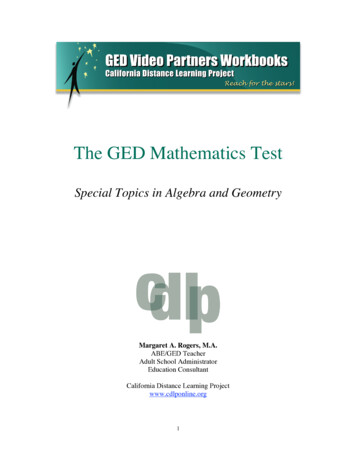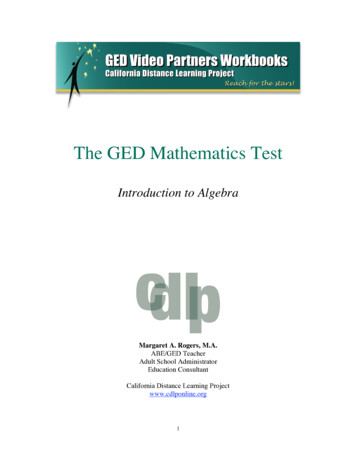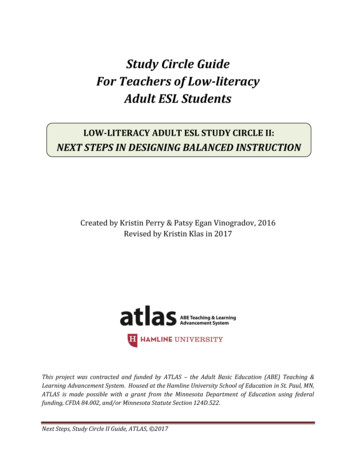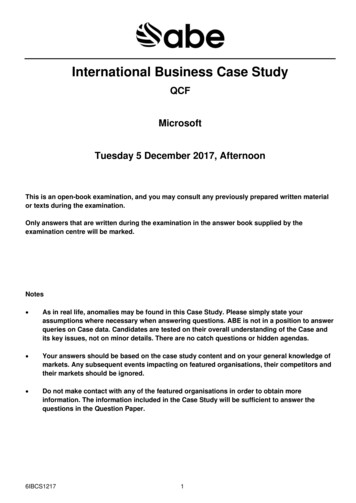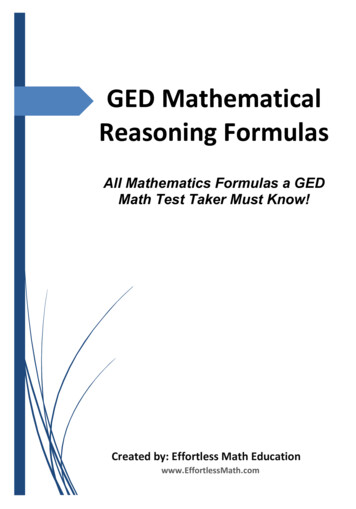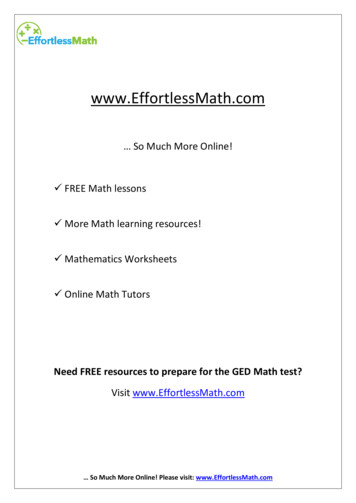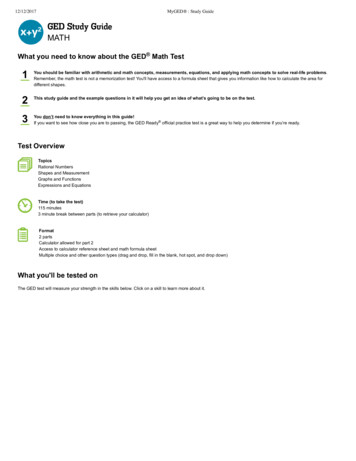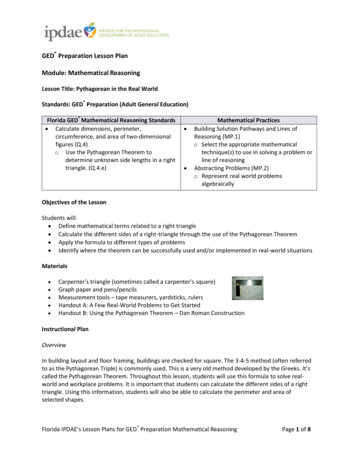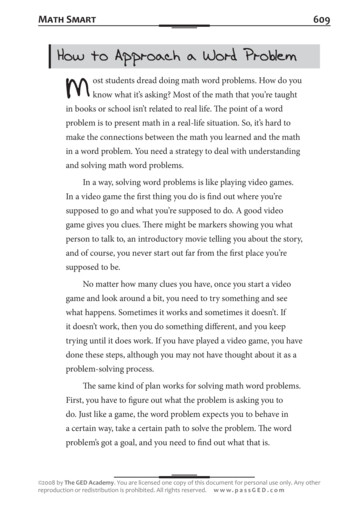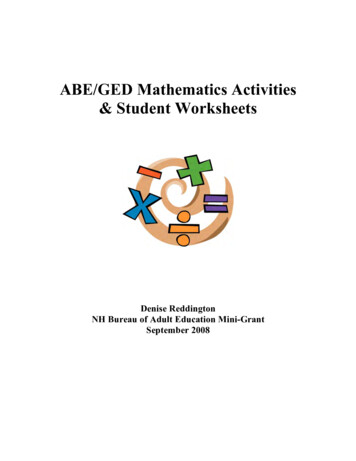
Transcription
ABE/GED Mathematics Activities& Student WorksheetsDenise ReddingtonNH Bureau of Adult Education Mini-GrantSeptember 2008
ABE/GED Mathematics Activities & Student Worksheets IndexIntroductionIndexMath Can Be FunGeneral Game and Activity IdeasBlank MATHO CardA&BCC&DEWhole NumbersPlace ValueNumbers, Numbers, NumbersRounding Whole NumbersWorld Population Math ActivityExponentsOrder of OperationsWages and Word ProblemsCard Games: Place Value & Multiplication iting FractionsDrawing FractionsMixed NumbersEquivalent FractionsUsing Cross Multiplication to Compare FractionsOne-HalfOne-QuarterDice Digit Fractions181920-21222324-25-262728DecimalsWriting DecimalsComparing DecimalsRounding DecimalsActivities Using Decimal Cards293031-3233-34Percent, Ratio & ProportionWriting Percents PlusPercent to DecimalDecimal to PercentFraction to PercentFinding the Percent of a NumberStore Discounts & Taxes3536373839-4041A
Finding 10% of a NumberNH Meals TaxThe Percent Box MethodPercent of Increase & DecreaseRatiosProbabilityHow I Spend My Day Activity424344-45-4647484950Activities Using Fraction, Decimal & Percent Cards51-52-53Data AnalysisMean, Median & ModeUsing a Heat IndexWind Chill Chart5455-5657-58AlgebraUnderstanding IntegersMake A Number LineUsing A Number LineOrdering IntegersRace To Ten GameSolving 1-Step EquationsSolving Equations –WordsEvaluate ExpressionsUsing Formulas-Convert Fahrenheit & CelsiusUsing Formulas-Find Body Mass IndexAlgebra MathoScientific -77GeometryAngles VocabularyTriangle VocabularyGeometry WordsTest FormulasCircle FormulasThe Coordinate PlanePlotting a Patriotic PairPlotting Points GameBlank Coordinate Grid787980-818283-84-8586-87888990Calculator FunUpside Down Calculator91-92B
Math Can Be Fun !Math skills can be taught , practiced and reinforced in many different ways. There are avariety of alternatives to the big GED books and the giant lists of problems found in someworkbooks. Math games and activities can be used in the GED classroom to engagestudents in the learning process while having fun. Worksheets can easily be modified,used in a variety of ways and turned into activities. Examples of this can be foundthroughout this booklet.Following is a summary of an article from Steve Sugar on “Ten of the Very Best Reasonsfor Using Classroom Games”. ( www.thegamegroup.com ) Games are fun with a purpose. Games give the student and teacher immediate feedback. Games provide an environment that transforms the passive student into an activepart of the learning process. Games engage players and motivate them to interact with the topic. Games encourage collaborative learning and team work. Games accelerate the rate of learning. Games allow the teacher to be flexible and add variety to their lessons. Games can be customized to any size class, even one-on-oneGeneral Game & Activity Ideas1. One way of turning a worksheet into an activity is by playing MATHO.Using the game sheet found on the following page, turn any worksheet into an activity.Write the answers to a worksheet (16 to 20 answers) on the board and have students copythe answers onto different squares on their game board. They then match the problemnumber on their worksheet with the answers on their game board by writing the answer inthe circle.Turn the worksheet into a game by having students work independently or in teams to bethe first to get 4 matches in a row, column or diagonal or to be the first to match all thequestions and answers.2. Use index cards in a variety of waysWrite questions on one index card and the answers on another in a different color.Students may also want to do this part. In teams or independently, have students matchquestions with answers. They could also play “Concentration”. Depending on the topic,the teacher could also deal out the questions or the answer cards to students and havethem match orally. The first one to get rid of their cards wins.C
3. Play I Have-Who HasThis game can be played using a variety of different math topics. For example, topractice whole number computation and vocabulary, prepare index cards prior to thebeginning of the activity. One card must be the “Begin Card”, start with that one. Therest of the cards must follow using problems that include one or more of the basicfunctions and the answer to another. Each card must connect to another. For example:“ Who has 10 x 10 ?” (this is the beginning card)“ I have 100, who has 100/10 ?”“I have 10, who has 25 150 ?”ect .ect .ect This game is fun to play with a small group, but could also be used independently. Thestudent could match the cards in a line on the table. Students may also want to maketheir own set of cards.The possibilities are endless.4. Check out Florida’s collection of ABE, Pre-GED and GED lesson plans.For 50 GED Math Lessons go ics/Mathematics.htmFor excellent Pre-GED Lessons that include worksheets go h.pdfFor ABE lessons on levels 1 to 8.9 that include worksheets go to:www.abeflorida.org/resources.html Scroll down to Learning Activities Resource Guideand click on the level you are interested in.The Matho Game sheet is on the next page. An example of how it’s used is on pages74 –75 in the Algebra section.D
MATHOE
Place Value Chart1
NameDatePlace ValueWrite the place and the value of the underlined digit.1.30,0302. 20,0883. 8,6144. 32,5745. 2,2306. 87,9537. 8,0048. 5,6759. 91,04310. 84,92911. 1,06612. 4,30013. 18,30514. 93,38815. 7,33016. 69,66917. 1,77818. 2,80919. 72,14920. 7,97721. 2,76122. 7,48523. 3,07224. 54,986tens or 30Adapted from EdHelper.com2
Place ValueWrite each number in standard form.1. 40 300 9,000 40,0002. 7 50,000 7003. 2 hundreds 5 thousands 4 ones 9 tens4. eight thousand, six hundred eightythree5. fifty-eight thousand, five hundredeighty-nine6. 5 ten thousands 9 ones 5 thousands7. 8 30 200 9,0008. thirty-three thousand, one hundredtwenty-eight9. 3,000 900 3 7010. six thousand, five hundred twelve11. sixteen thousand, nine hundred sixty- 12. 5 600 7,000 20,000five13. eighty-nine thousand, eight hundredtwenty-nine14. 50 2 2,000 20015. 6 tens 5 thousands 4 hundreds16. forty-one thousand, seven hundredseventy-two17. sixty-two thousand, six hundredseventy18. 8 thousands 9 ones 7 hundreds 8 tens19. 60 4,000 600 520. 70,000 700 4 70 7,000Adapted from edhelper.com3
NUMBERS, NUMBERS, NUMBERSArrange these numbers so that they answer the questions below:135721. Largest possible number2. Smallest possible number3. Largest even number4. Smallest even number5. Largest odd number6. Smallest odd number7. Largest number divisible by 58. Smallest number divisible by 59. Largest number divisible by 310. Smallest number divisible by 3113572Students can cut and manipulate the number squares above and use them asan aid to answer the questions.4
NUMBERS, NUMBERS, NUMBERSArrange these numbers so that they answer the questions below:2. Largest possible number2. Smallest possible number3. Largest even number4. Smallest even number5. Largest odd number6. Smallest odd number7. Largest number divisible by 58. Smallest number divisible by 59. Largest number divisible by 310. Smallest number divisible by 31Use your own numbers or have students come up with their own.5
NameDateRounding Whole NumbersTip . Put a dot over the number in the place you are rounding to.This is thenumber that will stay the same or go up one. Look at the number after the dot todecide. 5 or bigger and the number goes up, smaller than 5 and the number staysthe same.1. Round the following numbers to the nearest ten:a) 89d) 514b) 2,673e) 97c) 265f) 2,7532. Round the following numbers to the nearest hundred:a) 847d) 333b) 2,978e) 5,496c) 5,048f) 5553. Round the following numbers to the nearest thousand:a) 14,389d) 9,520b) 29,610e) 56,239c) 3,492f) 89,7434. Round the following numbers to the nearest ten-thousand:a) 24,987d) 24,033b) 37,096e) 295,474c) 145,302f) 77,3306
Rounding Whole NumbersComplete the 301822311727267
DownAcross1. Round 376 to the nearest hundreds place.5. Round 14,161 to the nearest tens place.2. Round 11 to the nearest tens place.18. Round 162 to the nearest hundreds place.3. Round 43,120 to the nearest hundredsplace.19. Round 52,081 to the nearest thousands place.20. Round 96 to the nearest tens place.4. Round 65,369 to the nearest hundredsplace.5. Round 12,306 to the nearest hundredsplace.21. Round 77,846 to the nearest tens place.22. Round 9,038 to the nearest thousands place.23. Round 71,018 to the nearest tens place.6. Round 833 to the nearest hundreds place.24. Round 74,314 to the nearest hundreds place.7. Round 5,692 to the nearest thousands place.25. Round 879 to the nearest hundreds place.8. Round 691 to the nearest tens place.26. Round 56,291 to the nearest thousands place.9. Round 75 to the nearest tens place.10. Round 38,283 to the nearest tens place.27. Round 89,899 to the nearest thousands place.28. Round 7,891 to the nearest hundreds place.11. Round 37,449 to the nearest thousandsplace.12. Round 14,528 to the nearest thousandsplace.13. Round 92 to the nearest tens place.14. Round 99,812 to the nearest tens place.15. Round 728 to the nearest tens place.29. Round 3,940 to the nearest thousands place.30. Round 63 to the nearest tens place.31. Round 255 to the nearest hundreds place.32. Round 40 to the nearest tens place.33. Round 781 to the nearest tens place.16. Round 539 to the nearest hundreds place.17. Round 18 to the nearest tens place.Adapted from edhelper.com8
WORLD POPULATION MATHUse the following World Population Chart to practice a variety of mathskills with your students. You could use any interesting information thatcontains numbers in the same way. Have students estimate the population of the world or of the UnitedStates Have students read and write their numbers Order the estimates Determine how far off (or how close ) the estimates are Have students brainstorm what they think are the 10 largest countriesin the world (not math but useful social studies information) Practice reading the large numbers once the chart is given out Round off the numbers Use the population numbers to review place value ( Switch thenumbers in the thousands place and millions place in the population ofChina and read the new number. What number is in the ten-thousandsplace in the population of Iran? ) Create word problems (How many more people live in China than theUSA? )9
RankCountryPopulationDate ofInformation1 World6,677,563,921July 2008 est.2 China1,330,044,605July 2008 est.3 India1,147,995,898July 2008 est.4 European Union491,018,677July 2008 est.5 United States303,824,646July 2008 est.6 Indonesia237,512,355July 2008 est.7 Brazil191,908,598July 2008 est.8 Pakistan167,762,040July 2008 est.9 Bangladesh153,546,901July 2008 est.10 Russia140,702,094July 2008 est.11 Nigeria138,283,240July 2008 est.12 Japan127,288,419July 2008 est.13 Mexico109,955,400July 2008 est.14 Philippines92,681,453July 2008 est.15 Vietnam86,116,559July 2008 est.16 Germany82,369,548July 2008 est.17 Egypt81,713,517July 2008 est.18 Ethiopia78,254,090July 2008 est.19 Turkey71,892,807July 2008 est.66,514,506July 2008 est.21 Iran65,875,223July 2008 est.22 Thailand65,493,298July 2008 est.23 France64,057,790July 2008 est.24 United Kingdom60,943,912July 2008 est.25 Italy58,145,321July 2008 est.20Congo, Democratic Republicof theWORLD POPULATION10
NameDateExponents52 5 X 5 255 is the base number and 2 is the exponent.The exponent tells you how many times to multiply thebase number by itself.Find the value.1. 22 2. 42 3. 32 4. 82 5. 6 2 6. 5 2 7. 92 8. 102 9. 72 10. 53 11. 23 12. 33 13. 112 14. 43 Use a Calculator for the following :15. 142 16. 152 17. 83 18. 103 19. 123 20. 105 11
EXPONENT MATCHCut along the lines. Have students match the exponents to their value. This activitycan be completed independently or as a team. They can also be used as flashcards.12
NameDateOrder of Operations1.7 9 3 12. 62 5 12 - 23. 90 - 40 40 x 24. 24 2 525.75 25 – 10 x 46. 1 5 9 97.(81 2) - 428. 24 – 22 x 59.5(10 10) 1010.(88 5) 15 (3 - 1)12.47 - 32 52 x 211.9 ( 15 25) 35 713
13. 93 - 1 2214. 12 60 6 5215. 92 - 5 1216. 56 8 417.18. 12 24 4 - 3(8 7) - 55 5 x 219. 60 x 4 - 25 x 231.2.3.4.20. 50 7 8 – 3 x 2FOLLOW THE ORDER OF OPERATIONSDo what’s in Parenthesis first ( )Do all Exponents and square rootsMultiply and Divide, left to right, whichever comes firstAdd and Subtract, left to right, whichever comes firstPlease Excuse My Dear Aunt Sally14
U.S. Department of Labor- Fair Labor Standards Act AdvisorWhat is the minimum wage?The federal minimum wage provisions for covered, nonexemptemployees are contained in the Fair Labor Standards Act. The FairMinimum Wage Act of 2007 included phased increases to the federalminimum wage. For work performed prior to July 24, 2007, the federal minimumwage is 5.15 per hour.For work performed from July 24, 2007 to July 23, 2008, thefederal minimum wage is 5.85 per hour.For work performed from July 24, 2008 to July 23, 2009, thefederal minimum wage is 6.55 per hour.For work performed on or after July 24, 2009, the federalminimum wage is 7.25 per hour.Many states also have minimum wage laws. Where an employee issubject to both the state and federal minimum wage laws, theemployee is entitled to the higher of the two minimum wages.Various minimum wage exceptions apply under specific circumstancesto workers with disabilities, full-time students, youth under age 20 intheir first 90 consecutive calendar days of employment, tippedemployees and student-learners.15
UNITED STATES DEPARTMENT OF LABOR EMPLOYEEINFORMATIONUse the US Dept. of Labor Wage and Hour Division Basic Information pageto help answer the following questions.1. What is the present federal minimum wage ?2. What is the overtime rate ?3. What will the federal minimum wage be in August of 2009 ?4. If you earn 6.50 an hour, what would your hourly overtime pay be ?5. If you earn 6.55 an hour, what would your gross pay be for 20 hours?6. If you earn 6.55 an hour, what would your gross pay be if youworked 40 hours.7. If you earn 7.25 an hour, what would your gross pay be for 20 hours?8. What is the hourly overtime rate if you earn 7.50 an hour ?9. If you earn 10.00 per hour, what would your gross pay be if youworked 50 hours in one week (include overtime) ?10. How much has the minimum wage increased since before July 24,2007 ?16
PLACE VALUE CARD GAMEStudents take turns drawing a card and placing them on their number sheet. Each personuses a deck of cards from 1 - 9. Once you have placed a card, it cannot be changed.The object of the game is to make the highest number. At the end, when all spaces arefilled, students take turns reading their number out loud. A point is given for the highestnumber.After students have played with six number spaces they could addtwo more number spaces, so it will look like this: . For areal challenge, add even more spaces.Another challenge is to place a decimal point onto your game sheet and repeat the game.For example:.X- CARDS ( 1 TO 5 FACTS)SKILL: Review and practice of multiplication facts to 50PLAYERS: Two of equal skill levelEQUIPMENT: Cards (Ace 1) - 10Players divide the cards into two piles. Cards A - 5 are in one pile, and cards 6 10 are in another pile. Each player has one pile of cards. At the same time, each playerturns over a card. Players multiply the two cards. The first player who says the correctanswer out loud, collects both cards.In the event of a tie, players leave their cards face down and let the pile build.Play resumes until one player gives the correct answer before the other and collects all ofthe accumulated cards.Play continues until the common piles are finished. Players count up their cards todetermine the winner. ******* This game doesn’t need to be a competition, studentscan take turns or play cooperatively.X- CARDS (1 – 9 FACTS)Players divide the number cards equally (ace – ten) and follow the rules above.17
NameDateWriting FractionsWrite a fraction to show how much of the shape is 8.For extra practice, go back and write the fraction that is not shaded.Adapted from edhelper.com18
NameDateDrawing FractionsDraw a picture to show the fraction.1. eight-tenths2.253. one-half4.5.236.499.34377. five-eighths8. five-sixthsDMR19
NameDateMixed NumbersWrite a mixed number and improper fraction for the parts that are shaded.1.2.3.4.5.6.7.8.9.10.20
11.12.13.14.15.16.17.18.19.20.Adapted from edhelper.com21
NameDateEquivalent FractionsFill in the missing number to make two equivalent fractions.1.2.2 843.104.35 35.1 26.3 647.3 428.23 6810 11.4 84 14.3 261015 12.213.89.510.69 241 362 3915.1 28Adapted from edhelper.com22
Use Cross Multiplication to Compare FractionsExample .Which fraction is the smallest ?3/7 or 2/3(9)37(14)233 x 3 9 and 7 x 2 149 14 so 3/7 2/3Use (less than), (greater than) or (equal) to compare the following fractions.Hint .the point of the arrow always points to the smallest 32116.394717.685718.252723
Understanding One-HalfAnswer as many of these questions as you can using mental math!Think of half pizzas to make it easier.1.11 228.52.1 229.10 123.111 22210.10 124.3–11.4 125.3–112.4 126.5 1213.6 127.111 12214.6 1212121–32Circle all the fractions that are greater than ½.341459263656374724
One Half 1/2 ,Fifty Percent 50% , Five Tenths .5Circle the fractions equal to 1/21/52/93/66/1215/305/92/6 4/812/258/1620/40Circle the fractions less than 1/2Hint .find half of each denominator. If the numerator is less than that number, thefraction is less than 1/2.2/62/82/33/4 3/106/104/95/151/36/104/85/9Circle the fractions greater than 1/2Hint .find half of each denominator. If the numerator is greater than that number, thefraction is larger than 1/2.4/75/63/52/3 3/45/116/147/151/38/1415/356/10Write 4 fractions less than 1/2.Write 4 fractions greater than 1/2.25
½ 50% .5To find ½ or 50% of a number: divide by 2 or multiply by½ or .51. What is ½ of 10 20 50 150 76 22815 452. What is 50% of 30.00 800.00 250.00 700.00 10.50 25.003. How many minutes are there in ½ of an hour 1 ½hours 2 ½ hours 3.5 hours4. How many hours are there in ½ of a day1.5 days 2 ½ days5. How many months in ½ of a year 3.5 years2 ½ years6. How many days in ½ of a year 2.5 years5 ½ years7. How many weeks in ½ of a year 1.5 years5 ½ years8. How many nickels in ½ of a dollar 1.5 dollars9. How many pounds in ½ ton 1.5 tons10. What is ½ of a million11. How many inches in a foot ½ of a foot2.5 feet 5 ½ feet12. How many feet in 1 yard 2.5 yards1 ½ yardsDMR26
¼ 25% .25To find ¼ or 25% of a number: Divide by 4 or multiply by¼ or .251. What is ¼ of 40 208 100 3682. What is 25% of 100.00 150.00 300.3. How many minutes in ¼ of an hour 1.25 hours4. How many hours in 25% of a day 1.25 days5. How many months in 1/4 of a year 1.25 years6. How many weeks in ¼ of a year 2/4 ¾7. How many inches in ¼ of a foot 2/4 ¾8. How many pounds in 25% of a ton 1.25tons9.How many inches in a yard ¼ of a yard 1.25 yards10. What is 25% of 2,000,000.0027
Dice Digit FractionsVariations:Students gain a wonderfu
Math Can Be Fun ! Math skills can be taught , practiced and reinforced in many different ways. There are a variety of alternatives to the big GED books and the giant lists of problems found in some workbooks. Math games and activities can be used in the GED classroom to
